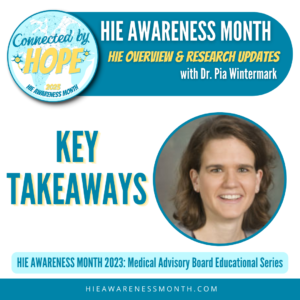
April marks the beginning of HIE Awareness Month, and what better way to kick off our campaign than with a live Q&A with Dr. Pia Wintermark – a renowned pediatrician and neonatologist at Montreal Children’s Hospital – about important HIE updates in the field?
If you missed her Q&A, no worries! We took notes, and like any good partner, we’re willing to share!
Therapeutic hypothermia is a technique that involves lowering an infant’s body temperature to between 91-92 degrees Fahrenheit for 72 hours after an HIE event. This method has been transformative in treating HIE, as it has the potential to prevent further brain damage by slowing down the brain’s metabolism and reducing its need for oxygen.
While therapeutic hypothermia is the standard of care for HIE treatment, this was not always the case. In fact, it was not until the late 1990s and early 2000s that researchers began to study the effectiveness of therapeutic hypothermia in treating HIE. The National Institute of Child Health and Human Development Neonatal Research Network trial was one of the first large-scale studies that found that many infants who received therapeutic hypothermia had a significantly reduced risk of death or disability compared to those who did not receive the treatment. Before these developments, HIE was often treated with supportive care, such as oxygen therapy and the use of intravenous fluids.
For this reason, this therapy has also been transformative in how an HIE diagnosis is perceived. According to Dr. Wintermark, medical providers now often have a way to give hope to families affected by HIE by offering many of them a course of treatment and care.
Upon the event of a neonatal brain injury and a transfer to the NICU, doctors will begin to use several tools to classify the HIE as mild, moderate, or severe: this is where Sarnat Classification Scales, MRIs, and clinical assessments come into play.
HIE has a wide range of outcomes that span the various classification levels, and unfortunately, there’s no manual or guidebook that can guarantee what long-term outcomes are associated with a mild, moderate, or severe level. However, we do know that infants’ brains are plastic – or more able to reorganize and stimulate new or non-injured neural pathways – and that this can play a crucial role in improving the long-term outcomes of children with HIE.
While plenty of research exists regarding gross-motor milestones, as they are more commonly studied, reported, and discussed in the HIE literature, new and innovative studies are beginning to examine long-term outcomes for non-motor challenges.
Dr. Wintermark and her colleagues at McGill University, for instance, are taking a novel approach to HIE research, for they are focusing on brain repair, rather than brain injury prevention, which has historically been the focus of previous studies and trials. This study involves giving Sildenafil to infants after cooling, with the theory that it can improve blood flow to the brain by relaxing blood vessels and promoting the growth of new ones. The study is ongoing and will take years to complete; however, it represents an innovative approach to addressing the long-term effects of HIE and could lead to new therapies and interventions to improve the lives of affected children.
As with any field of research, there are barriers that can impede progress and quality improvement management:
While there are certainly challenges to overcome, there is also much room for hope and optimism! The collaborative efforts of medical providers and researchers around the world, combined with the advances in technology and increased awareness and advocacy, are helping to drive progress towards better outcomes for children with HIE.
There is no denying that early interventions can have a significant impact on a child’s long-term outcomes; however, it’s important to note that there is such a thing as overstimulating a baby’s brain. Just like any other muscle, the brain needs rest in order to grow and develop!
Dr. Wintermark is no stranger to talking families through the daunting feeling of guilt or that they “aren’t doing enough.” Her response? Parents should not underestimate the power of simple activities like reading, talking, and spending quality time with their child. These activities can help to promote healthy brain development by fostering language skills, social interaction, and emotional bonding. Research has shown that reading to babies from a young age can have significant benefits for their cognitive and language development while talking and engaging with them can help to promote social and emotional growth!
Other resources, like Neo Brain Parents and the Newborn Brain Society, are invaluable in supporting parents and providers in the care of newborns with hypoxic-ischemic encephalopathy and other brain injuries. By providing access to information, resources, and support, these organizations can help to improve outcomes and promote the best possible care for affected newborns and their families.
If you found this blog helpful, watch the full recording on our YouTube channel to listen to Dr. Wintermark respond to poignant questions from our community!
Connect with families, read inspiring stories, and get helpful resources delivered right to your inbox.